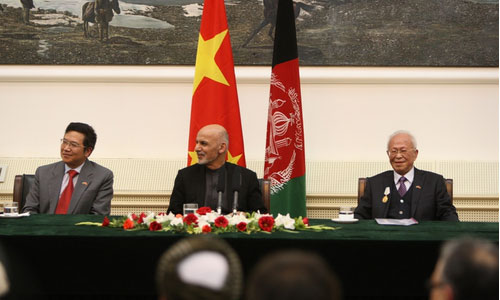Xi Jinping, President of the People’s Republic of China, once delivered a keynote speech at UNESCO headquarters, which on the subject of “Civilizations are colorful because of communication, civilizations are profound owning to mutual learning”. Afghanistan President Ashraf Ghani also expressed his appreciation for China’s adherence to good-neighborliness and friendliness policy. In the future, the cooperation between two countries will further develop in an all-round way in the fields of political security, economic development and cultural and educational exchanges.
All civilizations are equal. Only through equality can Chinese and Afghan civilizations exchange and learn from each other. And different civilizations have their own merits. Nor is there a civilization that is devoid of any merit. The global tour of Afghan historical relics started in 2007. By 2018, it has been exhibited in 23 museums around the world with more than 2.5 million visitors. In addition to displaying precious cultural relics, it also spread the story worldwide that brave and loyal Afghan people protecting national cultural heritage valorously. Over a dozen years from 1990 to 2001, the national museum of Afghanistan was severely damaged, but thanks to the unremitting efforts of the Afghan people, a large amount of cultural heritage has been successfully preserved.
Civilization is inclusive. Thanks to inclusiveness, the Chinese and Afghan civilizations have an impetus to exchange and learn from each other. Therefore, all the achievements of civilization deserve respect and should be cherished. And only by maintaining exchanges and mutual learning with other civilizations can a civilization be full of vitality. On 1th Feb 2018, the world-class cultural relics’ exhibition “echo of civilization” of the Afghan national museum opened at Chengdu museum in China. The exhibition covers the historical process of several periods in Afghanistan, including the Neolithic age, Greek civilization, Grassland civilization, and Guishuang civilization, presenting a picture of Afghanistan’s diversified civilization from the 4th century BC to the 3rd century AD. These precious cultural relics have witnessed the historical, cultural and economic ties between Afghanistan and China, especially Sichuan area. This is also the perfect presentation and interpretation of the connotation of “the Belt and Road”.
Civilizations are interconnected, and exchanges and mutual learning between the two civilizations can only be achieved through exchanges. And the dialogue between different civilizations highlights the mutual respect, equality and communication and combination among different civilizations. Afghanistan is a place where eastern and western cultures meet. Therefore, many similar genes can be found in the cultural blood of China and Afghanistan. China’s Xinjiang borders directly with Afghanistan. In June 2017, China’s Xinjiang cultural exchange delegation visited Afghanistan, which has built a bridge of communication for the cultural cooperation between Afghanistan and China. What “the Belt and Road” promotes is not only economic cooperation between the two countries, but also the infrastructure of civilization communication It is the “belt” and “road” connecting the civilizations of China and Afghanistan, as well as the “road of civilization” promoting the mutual understanding and cultural integration between the two countries.
Civilization is colorful. The civilizations of China and Afghanistan are diverse and therefore worthy of exchanges and mutual learning. Mankind has created and developed colorful civilizations in the long history. And both the Chinese and Afghan civilizations are the fruits of the efforts of people from China and Afghanistan. With a history of more than 4,000 years, the Afghan civilization, located at the intersection of grassland civilization, Greco-Roman civilization, Indian civilization and Chinese civilization, which has formed its unique cultural charm. As the popular lyrics of the Afghan patriotic poem “Afghan song” say: “Such as jade inlay in central Asia and west Asia mountain top... After thousands of years of vicissitudes, I stand still in the mountains and my history is full of heroes and legends.” This is a true reflection of Afghanistan’s ancient civilization.
In the future, the two countries can promote cultural exchanges and cooperation from the following five aspects: First, establish a cultural exchange and cooperation mechanism between Afghanistan and China under the background of “One Belt And One Road”; second, to improve the China-Arab cultural exchange and cooperation platform; third, to build a brand of cultural exchanges and publicity based on the long-standing friendship and cooperation between Afghanistan and China; fourth, to promote the prosperity and development of cultural industries between Afghanistan and China; fifth, to promote cultural trade cooperation between the two countries. On this basis, an all-round, multilevel and broad-field cultural exchange model will eventually be formed, so as to facilitate the smooth development of china-arab cultural exchanges.
Home » Opinion » The civilization of China and Afghanistan: Equality, inclusiveness, Mutual Learning and Diversity
The civilization of China and Afghanistan: Equality, inclusiveness, Mutual Learning and Diversity
| Mingzhe Ren, Shuyu Li & Daitong Liang

